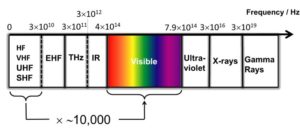What is Li-Fi technology?
Li-Fi technology is a ground-breaking light-based communication technology, which makes use of light waves instead of radio technology to deliver data.
Li-Fi can compensate as the radio spectrum becomes overloaded

Using the visible light spectrum, Li-Fi technology can transmit data and unlock capacity which is 10,000 times greater than that available within the radio spectrum.
The visible light spectrum is plentiful, free and unlicensed, mitigating the radio frequency spectrum crunch effect.
The future internet
Li-Fi technology will in future enable faster, more reliable internet connections, even when the demand for data usage has outgrown the available supply from existing technologies such as 4G, LTE and Wi-Fi. It will not replace these technologies, but will work seamlessly alongside them.
Using light to deliver wireless internet will also allow connectivity in environments that do not currently readily support Wi-Fi, such as aircraft cabins, hospitals and hazardous environments.
Light is already used for data transmission in fibre-optic cables and for point to point links, but Li-Fi is a special and novel combination of technologies that allow it to be universally adopted for mobile ultra high speed internet communications.
A dual use for LED lighting
The wide use of solid state lighting offers an opportunity for efficient dual use lighting and communication systems.
Innovation in LED and photon receiver technology has ensured the availability of suitable light transmitters and detectors, while advances in the modulation of communication signals for these types of components has been advanced through signal processing techniques, such as multiple-input-multiple-output (MIMO), to become as sophisticated as those used in mobile telecommunications.
An integrated communication solution
Li-Fi technology is being developed into a ubiquitous systems technology, consisting of application specific combinations of light transmitters, light receivers including solar cells, efficient computational algorithms and networking capabilities that can be deployed in a wide range of communication scenarios and in a variety of device platforms.













No comments:
Post a Comment